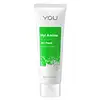What's inside
What's inside
 Key Ingredients
Key Ingredients

No key ingredients
 Benefits
Benefits

 Concerns
Concerns

 Ingredients Side-by-side
Ingredients Side-by-side

Water
Skin ConditioningSodium Laureth Sulfate
CleansingCocamidopropyl Betaine
CleansingSodium Lauryl Sulfate
CleansingSekken Soji
CleansingSodium Chloride
MaskingGlycol Distearate
EmollientDecyl Glucoside
CleansingPhenoxyethanol
PreservativeSodium Benzoate
MaskingPotassium Laureth Phosphate
EmulsifyingDistearyl Phthalic Acid Amide
EmollientCocamide Mea
EmulsifyingAcrylates Copolymer
PEG-120 Methyl Glucose Dioleate
EmulsifyingPEG-40 Hydrogenated Castor Oil
EmulsifyingGlycerin
HumectantCitric Acid
BufferingDisodium EDTA
Melaleuca Alternifolia Leaf Oil
AntioxidantButylene Glycol
HumectantCentella Asiatica Extract
CleansingSalicylic Acid
MaskingHyaluronic Acid
HumectantPentylene Glycol
Skin ConditioningMoringa Oleifera Seed Extract
Skin ConditioningSerine
MaskingHistidine
HumectantThreonine
Aspartic Acid
MaskingSodium Acetylated Hyaluronate
HumectantSodium Hyaluronate
Humectant1,2-Hexanediol
Skin ConditioningSodium Hyaluronate Crosspolymer
HumectantHydroxyacetophenone
AntioxidantHydrolyzed Sodium Hyaluronate
Skin ConditioningEthylhexylglycerin
Skin ConditioningCI 19140
Cosmetic ColorantCI 42090
Cosmetic ColorantWater, Sodium Laureth Sulfate, Cocamidopropyl Betaine, Sodium Lauryl Sulfate, Sekken Soji, Sodium Chloride, Glycol Distearate, Decyl Glucoside, Phenoxyethanol, Sodium Benzoate, Potassium Laureth Phosphate, Distearyl Phthalic Acid Amide, Cocamide Mea, Acrylates Copolymer, PEG-120 Methyl Glucose Dioleate, PEG-40 Hydrogenated Castor Oil, Glycerin, Citric Acid, Disodium EDTA, Melaleuca Alternifolia Leaf Oil, Butylene Glycol, Centella Asiatica Extract, Salicylic Acid, Hyaluronic Acid, Pentylene Glycol, Moringa Oleifera Seed Extract, Serine, Histidine, Threonine, Aspartic Acid, Sodium Acetylated Hyaluronate, Sodium Hyaluronate, 1,2-Hexanediol, Sodium Hyaluronate Crosspolymer, Hydroxyacetophenone, Hydrolyzed Sodium Hyaluronate, Ethylhexylglycerin, CI 19140, CI 42090
Water
Skin ConditioningGlycerin
HumectantLauric Acid
CleansingPalmitic Acid
EmollientButylene Glycol
HumectantPotassium Hydroxide
BufferingMyristic Acid
CleansingStearic Acid
CleansingCocamidopropyl Betaine
CleansingGlycol Distearate
EmollientOlea Europaea Fruit Oil
MaskingCocamide DEA
EmulsifyingMethyl Gluceth-20
HumectantJojoba Esters
EmollientAlcohol Denat.
AntimicrobialPolyquaternium-7
Potassium Chloride
DMDM Hydantoin
PreservativePEG-7 Glyceryl Cocoate
EmulsifyingCI 77289
Cosmetic ColorantParfum
MaskingDisodium EDTA
Dipotassium Glycyrrhizate
HumectantPropylene Glycol
HumectantEthoxydiglycol
HumectantGlucose
HumectantAesculus Hippocastanum Seed Extract
Skin ConditioningSalvia Officinalis Leaf Extract
CleansingEquisetum Arvense Extract
AstringentTussilago Farfara Leaf Extract
AstringentRosmarinus Officinalis Leaf Extract
AntimicrobialUrtica Dioica Extract
AstringentChamomilla Recutita Flower Extract
MaskingMelissa Officinalis Leaf Extract
Skin ConditioningYeast Amino Acids
HumectantTrehalose
HumectantInositol
HumectantTaurine
BufferingBetaine
HumectantPhenoxyethanol
PreservativePotassium Sorbate
PreservativeWater, Glycerin, Lauric Acid, Palmitic Acid, Butylene Glycol, Potassium Hydroxide, Myristic Acid, Stearic Acid, Cocamidopropyl Betaine, Glycol Distearate, Olea Europaea Fruit Oil, Cocamide DEA, Methyl Gluceth-20, Jojoba Esters, Alcohol Denat., Polyquaternium-7, Potassium Chloride, DMDM Hydantoin, PEG-7 Glyceryl Cocoate, CI 77289, Parfum, Disodium EDTA, Dipotassium Glycyrrhizate, Propylene Glycol, Ethoxydiglycol, Glucose, Aesculus Hippocastanum Seed Extract, Salvia Officinalis Leaf Extract, Equisetum Arvense Extract, Tussilago Farfara Leaf Extract, Rosmarinus Officinalis Leaf Extract, Urtica Dioica Extract, Chamomilla Recutita Flower Extract, Melissa Officinalis Leaf Extract, Yeast Amino Acids, Trehalose, Inositol, Taurine, Betaine, Phenoxyethanol, Potassium Sorbate
 Reviews
Reviews

Ingredients Explained
These ingredients are found in both products.
Ingredients higher up in an ingredient list are typically present in a larger amount.
Butylene Glycol (or BG) is used within cosmetic products for a few different reasons:
Overall, Butylene Glycol is a safe and well-rounded ingredient that works well with other ingredients.
Though this ingredient works well with most skin types, some people with sensitive skin may experience a reaction such as allergic rashes, closed comedones, or itchiness.
Learn more about Butylene GlycolCocamidopropyl Betaine is a fatty acid created by mixing similar compounds in coconut oil and dimethylaminopropylamine, a compound with two amino groups.
This ingredient is a surfactant and cleanser. It helps gather the dirt, pollutants, and other impurities in your skin to be washed away. It also helps thicken a product and make the texture more creamy.
Being created from coconut oil means Cocamidopropyl Betaine is hydrating for the skin.
While Cocamidopropyl Betaine was believed to be an allergen, a study from 2012 disproved this. It found two compounds in unpure Cocamidopropyl Betaine to be the irritants: aminoamide and 3-dimethylaminopropylamine. High-grade and pure Cocamidopropyl Betaine did not induce allergic reactions during this study.
Learn more about Cocamidopropyl BetaineDisodium EDTA plays a role in making products more stable by aiding other preservatives.
It is a chelating agent, meaning it neutralizes metal ions that may be found in a product.
Disodium EDTA is a salt of edetic acid and is found to be safe in cosmetic ingredients.
Learn more about Disodium EDTAGlycerin is already naturally found in your skin. It helps moisturize and protect your skin.
A study from 2016 found glycerin to be more effective as a humectant than AHAs and hyaluronic acid.
As a humectant, it helps the skin stay hydrated by pulling moisture to your skin. The low molecular weight of glycerin allows it to pull moisture into the deeper layers of your skin.
Hydrated skin improves your skin barrier; Your skin barrier helps protect against irritants and bacteria.
Glycerin has also been found to have antimicrobial and antiviral properties. Due to these properties, glycerin is often used in wound and burn treatments.
In cosmetics, glycerin is usually derived from plants such as soybean or palm. However, it can also be sourced from animals, such as tallow or animal fat.
This ingredient is organic, colorless, odorless, and non-toxic.
Glycerin is the name for this ingredient in American English. British English uses Glycerol/Glycerine.
Learn more about GlycerinGlycol Distearate serves as a pearlizing or opacifying agent in cosmetic products.
It's often included in cleansers and haircare products to give them a lustrous or shimmering appearance.
It is derived from stearic acid, a natural fatty acid commonly found in vegetable oils and animal fats.
Glycol Distearate isn't fungal acne safe.
Learn more about Glycol DistearatePhenoxyethanol is a preservative that has germicide, antimicrobial, and aromatic properties. Studies show that phenoxyethanol can prevent microbial growth. By itself, it has a scent that is similar to that of a rose.
It's often used in formulations along with Caprylyl Glycol to preserve the shelf life of products.
Water. It's the most common cosmetic ingredient of all. You'll usually see it at the top of ingredient lists, meaning that it makes up the largest part of the product.
So why is it so popular? Water most often acts as a solvent - this means that it helps dissolve other ingredients into the formulation.
You'll also recognize water as that liquid we all need to stay alive. If you see this, drink a glass of water. Stay hydrated!
Learn more about Water